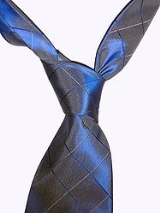
Four-in-hand knot
Encyclopedia
The four-in-hand knot is a method of tying a necktie
. Also known as a simple knot or schoolboy knot, the four-in-hand is believed to be the most popular method of tying ties due to its simplicity. Some reports state that carriage drivers tied their rein
s with a four-in-hand knot, while others claim that the carriage drivers wore their scarves in the manner of a four-in-hand, but the most likely etymology is that members of the Four-in-Hand Club in London began to wear the neckwear, making it fashionable. The knot produced by this method is on the narrow side, slightly asymmetric, and appropriate for most, but not all occasions.
Using the notation of The 85 Ways to Tie a Tie
, by Thomas Fink
and Yong Mao, the four-in-hand knot (knot 2) is tied
. It was used by sailors throughout the age of sail
for the rigging
of ships and remains a useful working knot today. Although topologically identical, when the knot is made in the manner used to fasten a flat necktie it appears somewhat different from when tied in cylindrical cordage for load-bearing purposes.
Necktie
A necktie is a long piece of cloth worn for decorative purposes around the neck or shoulders, resting under the shirt collar and knotted at the throat. Variants include the ascot tie, bow tie, bolo tie, and the clip-on tie. The modern necktie, ascot, and bow tie are descended from the cravat. Neck...
. Also known as a simple knot or schoolboy knot, the four-in-hand is believed to be the most popular method of tying ties due to its simplicity. Some reports state that carriage drivers tied their rein
Rein
Reins are items of horse tack, used to direct a horse or other animal used for riding or driving. Reins can be made of leather, nylon, metal, or other materials, and attach to a bridle via either its bit or its noseband.-Use for riding:...
s with a four-in-hand knot, while others claim that the carriage drivers wore their scarves in the manner of a four-in-hand, but the most likely etymology is that members of the Four-in-Hand Club in London began to wear the neckwear, making it fashionable. The knot produced by this method is on the narrow side, slightly asymmetric, and appropriate for most, but not all occasions.
Tying
The four-in-hand knot is tied by placing the tie around the neck and crossing the broad end of the tie in front of the narrow end. The broad end is folded behind the narrow end and brought forward on the opposite side, passed across the front horizontally, folded behind the narrow end again, brought over the top of the knot from behind, tucked behind the horizontal pass, and the knot pulled snug. The knot is slid up the narrow end of the tie until snug against the collar.Using the notation of The 85 Ways to Tie a Tie
The 85 Ways to Tie a Tie
The 85 Ways to Tie a Tie is a book by Thomas Fink and Yong Mao. The authors were research fellows at Cambridge University’s Cavendish Laboratory...
, by Thomas Fink
Thomas Fink
Thomas Fink is an Anglo-American physicist who has authored a number of journal articles on statistical and biological physics and two popular books. He is a Chargé de Recherche at CNRS/Institut Curie and when not in Paris lives in London....
and Yong Mao, the four-in-hand knot (knot 2) is tied
- Li Ro Li Co T.
Other uses
In more utilitarian settings the four-in-hand knot is known as the buntline hitchBuntline hitch
The buntline hitch is a knot used for attaching a rope to an object. It is formed by looping the rope around an object, then making a clove hitch around the rope's standing part, taking care to tie the two half-hitches that compose the clove hitch in the direction of the object, rather than away...
. It was used by sailors throughout the age of sail
Age of Sail
The Age of Sail was the period in which international trade and naval warfare were dominated by sailing ships, lasting from the 16th to the mid 19th century...
for the rigging
Rigging
Rigging is the apparatus through which the force of the wind is used to propel sailboats and sailing ships forward. This includes masts, yards, sails, and cordage.-Terms and classifications:...
of ships and remains a useful working knot today. Although topologically identical, when the knot is made in the manner used to fasten a flat necktie it appears somewhat different from when tied in cylindrical cordage for load-bearing purposes.
See also
- Small knotSmall knotThe small knot, or oriental knot or Kent knot, is the simplest method of tying a necktie, though some claim the simple knot is an alternate name for the four-in-hand knot...
– a lesser known but somewhat simpler necktie knot - Half-Windsor knotHalf-Windsor knotThe half-Windsor knot, also known as the single Windsor knot, is a way of tying a necktie which produces a neat, triangular knot. It is larger than the four-in-hand knot and Pratt knot but smaller than the Windsor knot. The half-Windsor is derived from the full Windsor in that it is only brought up...
– a more symmetric and slightly broader knot - Windsor knotWindsor knotThe Windsor knot, also referred to as a Full Windsor or as a Double Windsor to distinguish it from the half-Windsor, is a method of tying a necktie around one's neck and collar. The Windsor knot, compared to other methods, produces a wide symmetrical triangular knot. The knot is often thought to...
– a more symmetric and substantially bulkier knot - List of knots

